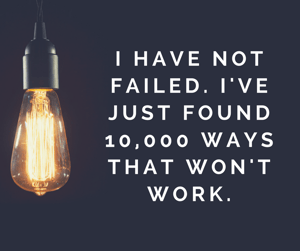Today we’re sharing insight from guest blogger Tara Nisenson, leadership coach and HR consultant. We hope you enjoy Tara’s wisdom and perspective.
 Many organizations are recognizing the power of involving much larger and diverse groups in generating innovative solutions to corporate dilemmas. Some company cultures react well to the initiative, others are much more cautious. Building a sustainable culture where everyone is happy to share ideas and contribute to company challenges can be difficult.
Many organizations are recognizing the power of involving much larger and diverse groups in generating innovative solutions to corporate dilemmas. Some company cultures react well to the initiative, others are much more cautious. Building a sustainable culture where everyone is happy to share ideas and contribute to company challenges can be difficult.
First, we must understand what we mean by innovation. We define innovation as a new idea, device, or method; the act or process of introducing new ideas, devices, or methods. Innovation is the introduction of something new.
How many of you remember a time before the iPad? What would you do without your smartphone? How did we get any work done before the laptop computer? Can you imagine a world without computers at all? Innovation is the process of coming up with something the customer didn’t even know they needed…and now they cannot now live without.
Innovation requires a diversity of opinions and ideas in order to create a fresh approach and attack problems in previously untried ways. This is best achieved by collaboration between different departments and minds, creating solutions that were never thought of before.
Second, we need to understand what employee engagement is and why it is important. Employee engagement is the emotional commitment the employee has to the organization and its goals. Employee engagement does not mean employee satisfaction or happiness. This emotional commitment means employees actually care about their work and their company. They don’t work just for a paycheck, or just for the next promotion, but work on behalf of the organization’s goals.
What does engagement look like?
- Discretionary effort
- Personal initiative on the job
- Vested interest in the company’s success
- Motivation to perform at the highest standards
- Hold others in the organization to high standards of performance
- Apply creative energy to their work
Now, how do we create a culture of innovative and engaged employees? The simple answer is to remove the barriers employees face when trying to create or deliver on innovative ideas. The more complicated question is ‘What is their biggest barrier?’.
In my opinion, the one thing that holds us back from innovation is fear. The fear of failure. Since the beginning of our elementary education, society has taught us that failure is bad, success is defined as winning, and if you are going to do something, do it right. These are the constructs that have created a culture afraid to fail in our society. We need to allow our employees to try new ways of doing things without the fear of it effecting how their performance is viewed within the organization.
Thomas Edison once said that “Many of life's failures are people who did not realize how close they were to success when they gave up.” This is the philosophy we need to instill into today’s corporate cultures if we are going to build an effective team of engaged innovators.
 What do engaged innovators look like?
What do engaged innovators look like?
- They love what they do and who they are!
- They hold others accountable!
- They come up with great ideas!
- They want to implement those ideas!
- They work hard to get others on board!
- They may make lots of mistakes, but learn from every one of them!
We need to reward innovative efforts, even if they aren’t 100% successful. When asked how many times he failed to make the light bulb, Thomas Edison simply replied “I have not failed. I've just found 10,000 ways that won't work.”
What’s The Risk?
What’s the risk of not innovating? When companies are successful, sometimes they fall into the trap of maintaining the current situation and they stop looking for ways to improve on the processes they have in place today. If you look at Blockbuster Video and Borders Bookstores in their prime, they were focused on maintaining their prowess in their markets. No doubt successful for a long period of time, their downfall started when they stopped looking for the next step in innovation and technology. They were so fixated on preserving their business model that they failed to see the Amazon’s and Netflix of the world coming up behind them. We cannot survive by ensuring the status quo in this age of technology and innovation. We must always be helping our employees to develop the next great idea!
This content was written and shared by guest blogger Tara Nisenson.
 With over 15 years of working in Human Resources, Tara’s true passion has always been to help people grow to their greatest potential. Her goal is to help her clients and their leadership teams find their strengths and own their authentic leadership style.
With over 15 years of working in Human Resources, Tara’s true passion has always been to help people grow to their greatest potential. Her goal is to help her clients and their leadership teams find their strengths and own their authentic leadership style.
Tara is a Certified HR Generalist, a Certified Gallup StrengthsFinder Coach and a DISC Communication Style expert. She is also a certified John Maxwell Team Speaker, Coach and Trainer who speaks and facilitates workshops on a number of leadership and employee engagement topics.
A graduate of Our Lady of the Lake University in San Antonio, Texas with her Bachelors of Arts in Human Resources, Tara went on to continue her education at Capella University where she received her Masters of Science in Industrial & Organizational Psychology.




